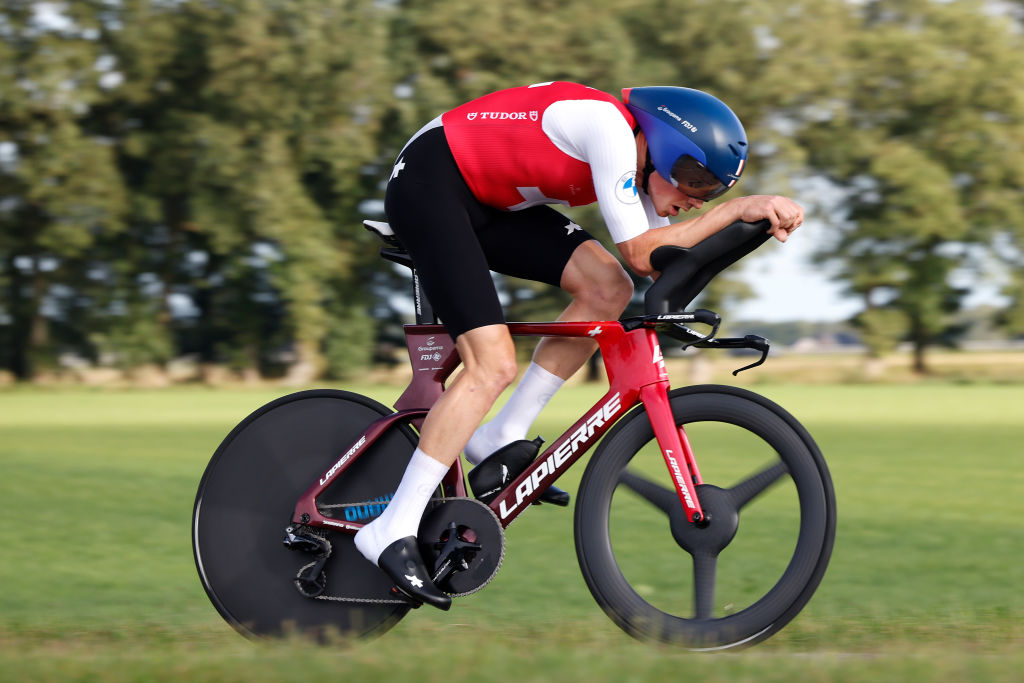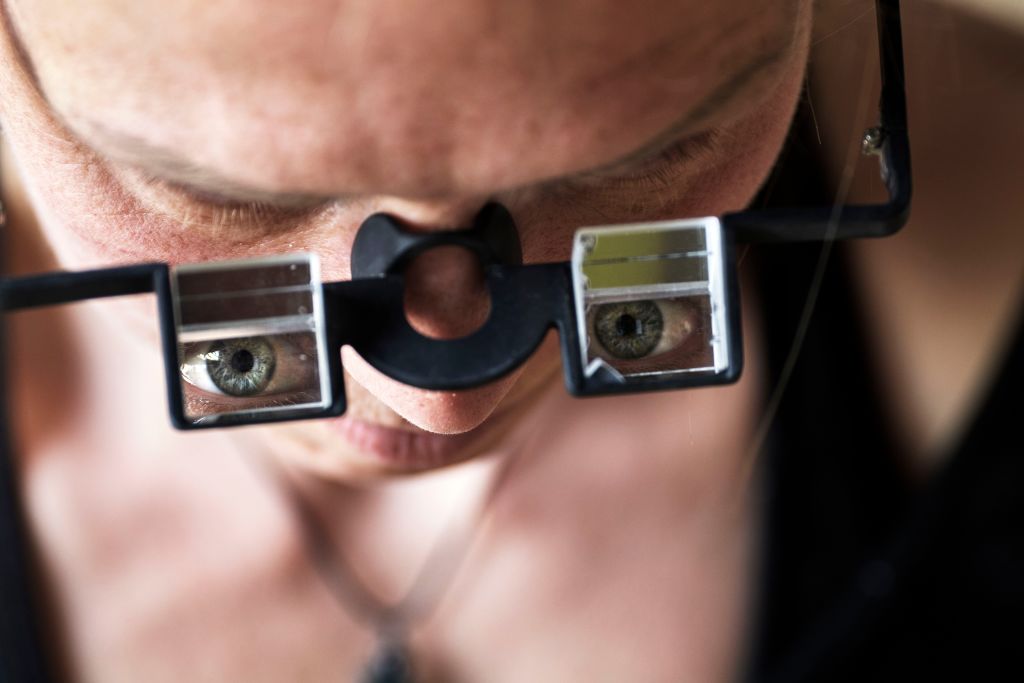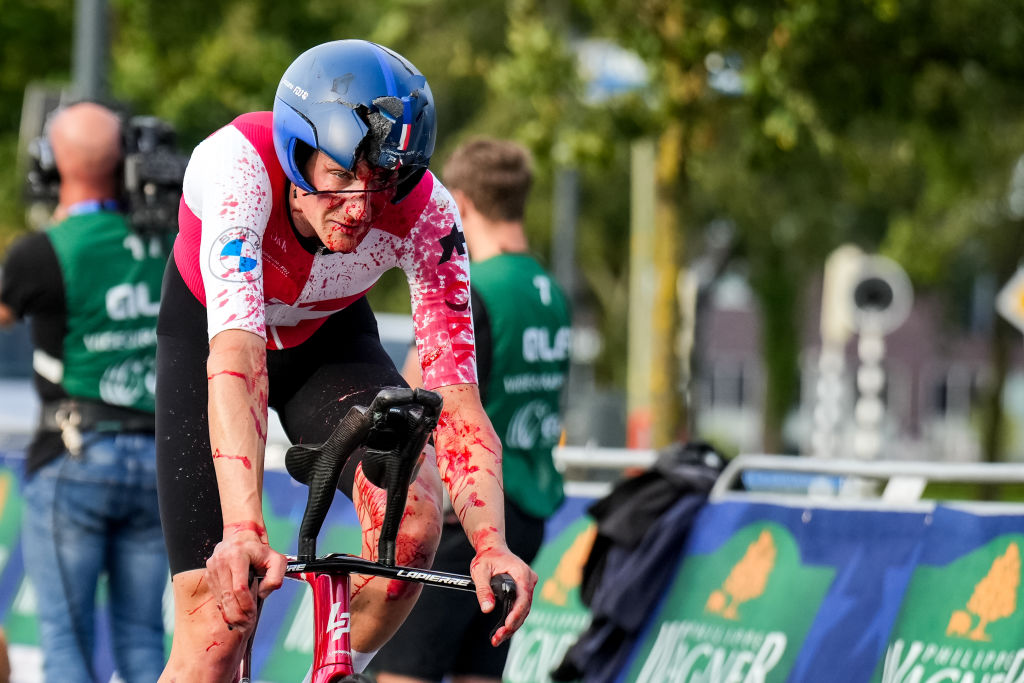
Gruesome images of Stefan Küng crossing the finish line with a blood-spattered skinsuit and shattered helmet after he rode headfirst into the barriers at the European Championships in September provoked a lot of debate about what should be done about the dangerous time trial position that he himself admitted caused the horror crash.
Küng, who suffered a broken cheekbone, fractured hand and concussion, claimed that while riding a TT he was “basically blind… I can only see a few metres ahead”. Swiss media channel SRF reported that Küng could only hold his “horrendous” pace if he kept his head down and trusted the instructions in his ear via radio from the team car. Except this time Küng hadn’t received a warning and didn’t realise the course wasn’t following the expected direction until he hit the barriers.

Brian Cookson OBE, former UCI president, wrote on X: “The crazy trend for head-down riding in time trials strikes again. UCI really must look at the technical rules to stop this.”
In fact, the UCI had already looked at the technical rules in an attempt to combat head-down riding, this year introducing three height categories that taller riders such as Küng, who is 193cm and in the new category three for riders 190cm+, could adopt a higher hand position. This meant that in theory there would be no need for tall riders to try to close the unaerodynamic gap between head and hands by dropping the head. However, Küng’s interpretation of the regulation had led him to a position where although he wasn’t staring at his front hub any more, he was now riding with his face buried in his forearms and was still, by his own admission, unable to see more than a few metres ahead.
Clearly the introduction of height categories had backfired. What next?
We asked the UCI’s head of innovation Mick Rogers, who replied to say he had forwarded our question to the governing body’s communications department. We hadn't received an answer by the time we published this story, but will update it if and when we do.
Users of X, formerly Twitter, ventured various solutions, some quite reasonable and some decidedly unrealistic. Belay glasses were one idea, as used in rock climbing: thanks to prism lenses, the person belaying doesn’t strain their neck by constantly looking upwards at the person climbing. Another was forward-facing radar. Yet another was a helmet or a fairing designed to allow the rider to look up with no aerodynamic penalty.

But perhaps the biggest problem for the UCI would be how to police or enforce a head-up position. Multiple time trial champion Michael Hutchinson, who is developing a skinsuit for the Irish national team for the 2024 Paris Olympics, has some suggestions.
“The best I’ve come up with as an actual solution is to have a pre-start check on a turbo of the ‘how many fingers am I holding up’ variety and take some images of that to compare during the race if a commissaire feels someone is riding head down. But it doesn’t feel very satisfactory not least because the during-race images are going to be hard to get.”
The other problem for the UCI is that it’s not always easy to judge how much a rider can see just by looking at them, observes Hutchinson.
“You can sit in a wind tunnel control room muttering ‘no way can they see’ then you go to the tunnel test area, check what they can see and realise they can look straight ahead.”
Dr Xavier Disley of AeroCoach, the UK company which works with WorldTour teams on improving aerodynamics, agrees that capturing a rider’s position during the race with video or still photographs might not provide a definitive answer, and also points out that: “Regulating things based on pictures and video feeds is bad because that almost means that if there isn’t someone with a camera following you you can get away with murder.”
Disley suggests that disqualification for dangerous riding could be one way to deter head-down riding, just as riders can be penalised or disqualified for irregular sprinting or for adopting the now-banned ‘puppy paws’ or ‘super tuck’ positions.

“I think the UCI did really well with puppy paws,” says Disley, recalling Marianne Vos’s disqualification for just three seconds of the position in 2022. “Now people aren’t doing it any more.
“So I think the precedent is already there for riders to get sanctioned if they’re doing stupid things, and people are forgetting this when they’re calling for a ban on head-down time trialling. Someone can ride with their head down on a road bike too, slam into the back of another rider and they would get sanctioned. It [head-down riding] actually is banned because you’re not riding safely. So what we need is for a high-profile example of someone getting DQ’d from a race for it."
So how much faster does the head-down position actually make a rider and what might they lose by not using it?
"Riding head down isn't always more aero"
Dr Xavier Disley of AeroCoach
“It’s totally individual,” says Disley. “It’s not always more aero. It depends on your helmet, the shape of your back, and if you have your head too low it’s not always faster. And if you’re having to bob your head up and down to see where you’re going, are you actually saving anything? And the concentration for looking up, looking down again, guessing what’s ahead of you on the road… it seems like a silly thing to do compared with if you do your homework and get a position where you can see where you’re going the whole time so you can focus more on pushing with your legs rather than, oh, is my head touching my hands or not.”
Disley continues: “There’s one particular rider we’ve [optimised position for] this year, a pro rider who shall we say is rather good at time trialling [AeroCoach doesn’t explicitly advertise who it works with, but by looking at which teams use its equipment it’s possible to make an educated guess]. Most of what we’ve been working on is to allow him to see where he’s going. Keeping the same aero drag he had with a head-down position, which is what he had before, but allowing him to see where he’s going and making it less variable between holding his head up and his head down. I would suggest that’s the way to do it. In a Grand Tour time trial there could be anything… uphills, downhills, road furniture, people standing in the road, so it’s much more consistent to have a position where you can see all the time.”
We say

The UCI has been famously quick to ban everything from the Superman position to socks that are too high. But for once it seems to be burying its head in the sand – or perhaps in this case in its forearms – leaving riders and teams to self-police their time trial positions.
A pre-race sight test, as suggested by Michael Hutchinson, and some high-profile disqualifications, as Xavier Disley suggests, might encourage riders - and the teams that support them - to work on finding positions that allow them to see as well as go fast.
The problem for the UCI – and every sport’s governing body – is that teams will always try to find loopholes or bend the rules to go faster, and so, unless safety is enforced, speed will always come first. However, the UCI has promised us an answer and in reality there's no immediate need for a rule change as the 2023 road season is over – so watch this space.







